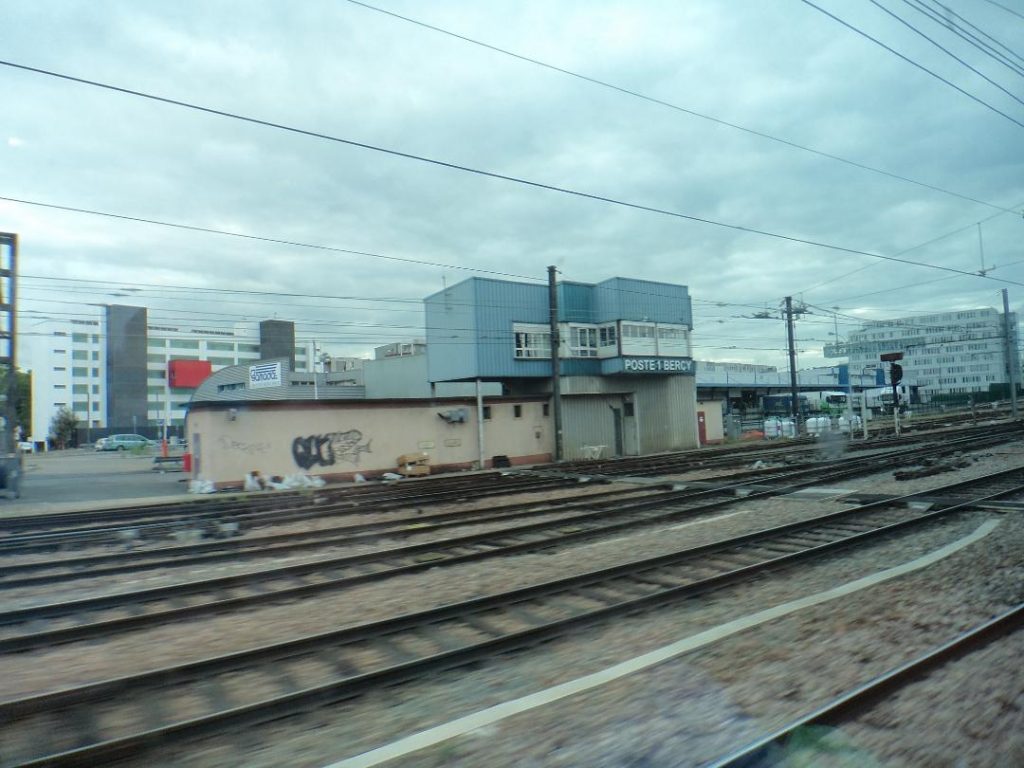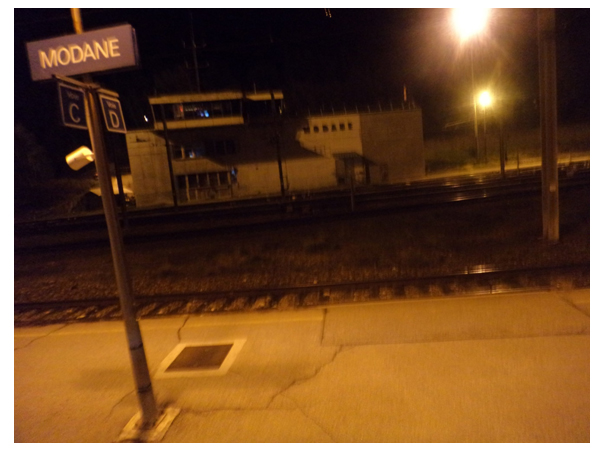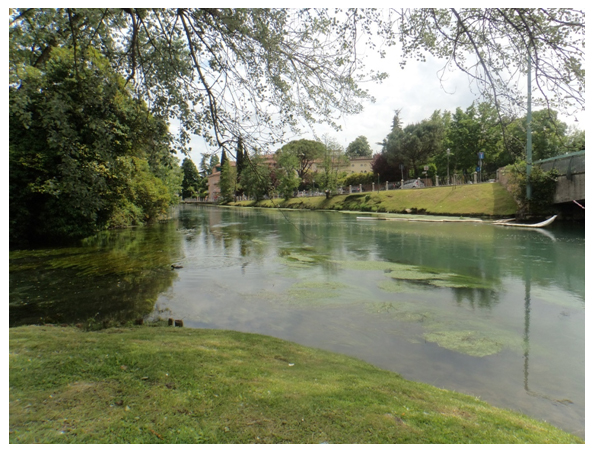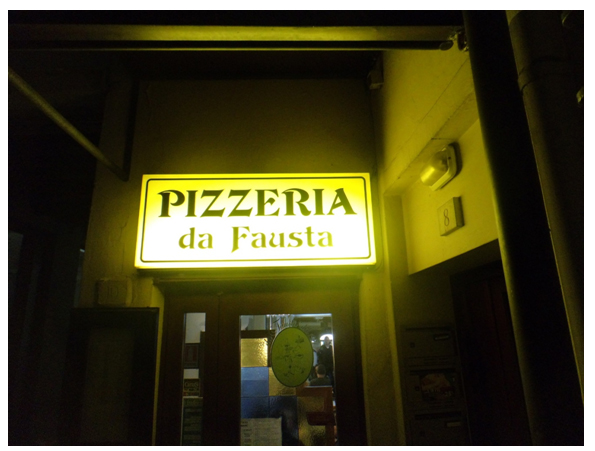Oxenholme to Treviso – side-tracked by the yearning ghost of W.H. Auden . . .
 Sex sells, Treviso, 12th May 2019: “My good-looking friend reclined on just about every bus that passed. Can’t remember if she was selling the sunglasses, the inflatable doughnut, the bikini or the trainers . . . and she never turned up at Faust’s Pizzeria – honestly!”
Sex sells, Treviso, 12th May 2019: “My good-looking friend reclined on just about every bus that passed. Can’t remember if she was selling the sunglasses, the inflatable doughnut, the bikini or the trainers . . . and she never turned up at Faust’s Pizzeria – honestly!”
It’s good to think that in some tortuous way the railway tracks visible from our windows at home, connect us with half the world. Yet the same can be said more certainly with roads or water or air. Is it only my inborn enthusiasm for railways which escalates the significance of their metalled courses?
The intensity of our most extreme enthusiasms, at least when they don’t appear to chime with the natural instincts of sex or hunger or swimwear, can often only be (whimsically) explicable as indicators of past lives. Though this isn’t a possibility I seriously believe in, the thought occurred again, a week after we got back from Italy, on a high crag overlooking Haweswater. Too cold and wet to likely encourage the visionary type of experience I frequently hope to repeat[i], shivering as I ate my lunch, I found myself indulging the fantasy of the fugitive or the spy. Had I not just escaped over Gatescarth Pass? With freezing hands and drizzle increasing, Auden’s poem, later titled The Secret Agent[ii] came easily to mind. Control of the passes was he saw the key . . .

Haweswater from the scree slope (with ghost), June 2019
I didn’t entirely realise until later, how a ghost had materialised from a raindrop on the lens of the camera. Was it this, my act of photography carried out moments earlier, which had invoked the spirit of W.H. Auden via his early moorland fantasies?
The thrill of the best of Auden’s topographical and psychological missions – lurking by rail lines and broken sheds, their earthbound shafts and guiding chimneys lost and abandoned on bleak fells – seriously upgrade the childish desire for a gigantic train set. In thrall to a wasteland of ruined mines, to the vast tapestry of bygone history, the full depth of whatever individual sense of the weird – wyrd in the Anglo-Saxon sense of fate – we may possess, might evade even our own self-respect; how likely is it that we can appreciate such mysteries in others? How often do we choose to ignore it instead, just to avoid the tangle in the head? The sense of destiny that may prompt certain insights or drive some personalities away from the fold, may equally confuse, confute or escape any definable mission or vocation. Yet the half-intuited apprehension of such middle-earths, archetypal or apocryphal, remains to me compelling. I’ve never been a fan of Tolkien, but I can understand why so many people are.
Although such poems as The Watershed[iii] may not be the best ever written, they remain among my favourites. That giant train-set I steadily grew out of wanting – without ever losing the treasure of the dream in my mind – I know if I had such a set now, it would only charm me for an hour or two. The best of Auden’s early poems, the collective-unconscious, universal kingdom they echo, is more complex, and luckily, they are perfectly able to exist outside both actual places or the person Auden himself may have been. Such contradictions, this confusion and diversity within people – all the other directions they might have taken – was the other reason his ghost bloomed on that fellside. Our inner faults and caverns too, struck me hard, as well as the cycle of the seasons, the tantalising, paralysing, love of place, my sense of home and of exile . . .
On the cold fellside, as the drizzle fell, I found in my coat pocket, the last of a packet of salted peanuts bought in blazing Perugia, and suddenly it was as if the heat of Perugia was now, while this Cumbrian fellside was the past. Memories can be like that. They take over. They become more real. An aging body, stranded in time, was exiled for a moment from an ageless mind, choosing warmth – perhaps as a form of belonging? Naturally this separation didn’t last, but before I grew too cold-deadened to be able to stay, I remembered how several weeks earlier, as our train sped across France towards encounters with places such as Perugia, I had questioned again my inner faults and divisions, my paralysing love of place, the sense of home and exile. For in the past, travelling was painful for me, painful in a good way, but severely debilitating. Whether at Dover, Plymouth or Newhaven . . . I could not bear to leave the English coast behind. Over the years this suffocating dismay of separation has loosened its grip. Thinking of the idea of belonging and of Englishness, I recalled my copy of Edward Mendelson’s anthology, The English Auden[iv]. Laughing to remember various lines from Auden’s flippant, far too clever, Letter to Lord Byron, (humorous, upmarket doggerel it could be said), on the night train somewhere between Dijon and Lyon and later in the night mountains at Modane, I composed an imaginary communication to the poet[v], a telegraphed message to travel back, forwards or sideways in time.
With the beds down and the corridor door shuttered off, in the dark, with everyone trying to be asleep, the rushing speed of our compartment was not governed by ordinary laws. The silhouette of wires and strange French pylons were just visible between the occasional blurred blaze of dashed-through stations. Feeling through the luggage for my exercise book and then lying on my side, I wrote this legendary draft of an imaginary email in pencil – apprehending the shapes of the abbreviated words as darker areas that might have been woods and lighter rocks that may have been limestone, passed outside . . . passed like similar masses in my mind, while every now and then we exploded underground. I knew I would have to finish it in the future, this message written in invisible ink, on the back of a map, in the hope that I might later find somewhere to send it. Its rough argument was extended by the light of a station lamp at Modane in the Auvergne-Rhône-Alpes. After which, with the not-so-stately procession of travel, of heavy bags and heavy rain, floods, sweltering heat and mosquitoes, I forgot all about my scrawled bafflements, endorsements and criticisms, and the fact that I had no sort of address. Above Haweswater a month later, perhaps Auden’s ghost, querulous or calm, had come back to transmit the answer to something it had already received from me, parting easily who were never joined?
* * * *
Oxenholme was where we began our Viaggio in Italia[vi], but we were no George and Ingrid encumbered only with each other – we had two young daughters in tow along with their keepsake totems and dolls to ward off homesickness:
 Electrified by the speed of the Eurostar, 9th May 2019
Electrified by the speed of the Eurostar, 9th May 2019
Ignoring the Pendolino and all points south, we reversed by day the route of the LMS Night Mail[vii], as indispensably hymned by Harry Watt, Benjamin Britten, Auden[viii] and others in 1936. A fast walk brought us to the revamped St. Pancras, where the International station and the hotel try to hold each other at a distance. The whole atmosphere is unrecognisable from 1978, at which time the crumbling gothic hotel, starved of funds, appeared little more than floors of shabby attic rooms treated with contempt. Underused by British Rail, (a national property that should never have been flogged off), I had an interview for trainee train driver in two of these run-down chambers, and in due course was offered a post either at Cricklewood or Northampton. What different rails and pointwork my life might have jumped, had I accepted?
Back in 2019, after check-in and customs, passengers descend to what was once a huge storage area for Burton’s Beer[ix]. The original structural columns are all visible and nicely painted between plush settees and the army of excessive wheelie suitcases passengers are over-generously permitted. There we wait as if for the call to heaven or hell, for the call to the escalator. This suspension, until departure from the sliding platforms and the speeding across Kent, I have wilfully blanked. Making up for my sojourn in the Borderlands with Auden, in this version of truth, after several dark blinks and repeated swallowing to adjust to the air pressure of tunnelling, we are already surfacing in France. Retrospect is great for the way it blithely alters time.
It was the 9th of May and my chief fear had been claustrophobia. I don’t like trains when they get crowded and if I notice the fact – notice innocent travellers boxing me in – I have to go and stand by the doors, ready to leap off at the first empty platform, to find the concrete of the realer world. Most of all I had dreaded the Channel Tunnel. I don’t have Auden’s fascination with nosing underground[x]. But apart from some over-upholstered, over-intrusive headrests on the Eurostar (happily absent on the way back), barely nothing disturbed my unusual equanimity, despite having neither wine nor beer. Perhaps I was pacing myself: “I have more than three weeks of this, I need to be calm, ethereal, observational”. This calmness went out of window at the sight of the first visibly Pas-de-Calais dwelling – a nothingy lineside cottage with crucial shutters. Oh, what a relief to be out of Brexit Britain! Briefly, I felt the fantasy 60’s world of Hammerhead[xi] – those long ideal avenues stretching southwards. More seriously, I felt the way Cyril Connelly, Graham Sutherland, Michael Powell and others must have felt when at last after the Second World War, Europe opened up to them again. But rather than five or six years, we had waited ten. It was in 2009 that we last crossed the Channel, on a ferry from Plymouth. Ten years since we had stood on non-English ground. Not that we were exactly standing now. In fact, rather than a rushing, insulated, air-conditioned train, I wished we were in our 57-year-old battered car without a roof. In that, you can feel the land beneath your wheels. In that, the driver becomes one with the car, an extension of its chassis and defiant engine – for which privilege the only cost (apart from the inevitable burning and damage of fossil fuels) is that of keeping your concentration ahead. On the train, we could all stare at everything. Of course, when viewed as an insulated skim, northern France soon reveals its less than ideal, plateau similarity . . .
In Paris, after all our sitting, there was just enough time for the long-and-had-to-be-done-fast walk from the Gare du Nord to the Gare de Lyon. Despite lugging a 30kg rucksack we were determined to follow a scenic route down boulevards Magenta, Strasbourg and Sebastopol to follow the Seine[xii].
By the time we reached the Pont d’Austerlitz, I was pouring with sweat with no chance for a shower. It was at the Gare de Lyon at one epic platform’s end by some older electric locomotives, that I thought of Jean Gabin, engine driver in La Bête Humaine[xiii], (1938). The spectacular travelling shots in Renoir’s adaptation of Zola’s novel, are worth watching the film for alone. But my mind was running late: Jacques Lantier’s route was Calais to Paris, the one we’d just done . . .
 Signalbox at Bercy, May 9th 2019
Signalbox at Bercy, May 9th 2019
With the Thello[xiv] accelerating through the Paris suburbs our sense of journey was born again. The Thello is a pretty real train by modern standards – it had the right sound and feel. The rails and points were noisy and properly jarring. Stations and yards and unusual buildings and transformer complexes were soon flashing past and the landscape improving. I feel like I’ve been let out of prison at last! On a proper train, train travel becomes a form of second-level visionary experience! Also, on the Thello, the windows of our four-person private compartment actually opened – if not halfway, as they did not so long ago. The whole fad of air-conditioning is something I just don’t get. If you have to live somewhere really hot then maybe; but on something moving, I would rather have the moving air. Leaning from the windows of trains used to be one of life’s great pleasures[xv]. At least the signs indicating that one shouldn’t throw bottles from the window made us laugh.
Auden may have been a “talismanic figure”[xvi] to his contemporaries, and his poems, “seminal”[xvii] – but his “negligent brilliance”[xviii] can be as estranging as it is engaging. Having lived in the North Pennines myself for seven years, it’s easy to believe that Alston Moor, Rookhope (“a sacred landscape”[xix]) and surrounding areas, always remained his Amor Loci. That the concentrated, psychological dreamscape of the poems inevitably forces certain subtleties of the eternal place away, does not bother me. My estrangement arises from the clash between the sincere and the merely clever – and perhaps also with the difference between being privileged and being poor? Most who lived and still live in the North Pennines exist on the margins, and the fell landscape, is typically harsh and cold. Compared to human life, such landscapes go on geologically – the human relics will be absorbed[xx]. In the end, towns and cities are more popular – or at least the windless orchard or the green-centred village of the heart. Auden, perhaps half wish-fulfilling himself as the Icelandic or Anglo-Saxon narrator/hero of his early sagas – places flung forward in time to inter-war depression and anticipating the Age of Anxiety – didn’t take long to became bourgeois and sedentary. The early “firebrand” becoming the later “conservative.”[xxi] Who wouldn’t, given his background, his degree of early acclaim and inevitable prominence? The ghost summoned by that raindrop on the scree of Artlecrag Pike above Haweswater, was that of his youthful idealism, the essence behind all the unnameable desires we can never satisfy: everything vivid “from the very first coming down”[xxii].
Since our psychic reunion, I have wavered back and forth between empathy and resistance towards Auden, re-lived my complex train-set enthusiasm and rebelled against it: for sometimes, (though never in the best poems), the hero or spy or fugitive can be seen less charitably, as a potential scout-leader of nerds and nitwits for whom the fells are no more than a spiffing adventure, a day’s shooting, something akin to Oscar Wilde’s “unspeakable in full pursuit of the uneatable“. What’s it all for? A fox’s brush nailed to the wall? A brace of birds, likely tossed in the bin? Or an over-clever poem liable to betray its sun and its cloud? Auden himself clearly realises the dilemma of his own fracture all over the place (not least in The Orators), but just as Fellini ends up revelling in the things he was trying to satirise, so Auden often cannot resist the gravitational pull of surface intelligence, the temptation to display “the greatest mind of the twentieth century”[xxiii].
Although I can see why the North Pennines Heritage Trust[xxiv] would wish to claim him, for all Auden’s recurring love for the area, and his claims to “like it cold”[xxv], he never lived there. Essentially his love was for a landscape of the mind – and there is nothing wrong with that: that’s where all the best landscapes carry on living, ignoring time.
As we did with Dartmoor in exile periods when it was far away, Auden hung an OS map of Alston Moor on the wall of his “chaotic shack on Fire island”[xxvi]. Later, it hung in his house at Kirchstetten in Austria.

En route to Modane, 9th May 2019
Darkness fell on the way to Dijon. Confused by the two-hour difference between the only clock we carried – locked on Greenwich Mean Time – and Continental time, I’m not exactly sure where. Like many sleepers, the Thello doesn’t go bonkers all the time. Its speed is erratic. It fits between other trains and is allowed fourteen hours twenty minutes to get from Paris to Venice. The theory is that you dine and talk and then sleep for eight hours to rise for a relaxed breakfast as the train speeds or trundles across Lombardy and Veneto. In reality, on night trains, I can rarely sleep. It’s just too exciting. Perhaps if I did the journey once a week, it would be different. On the return, I managed twenty minutes or so somewhere in the pre-dawn of southern France. On the way, I don’t think I managed any unconsciousness at all, just a few liminal periods of junctions and flyovers, signal lights and double-slips. Thousands of half-thoughts racketed through my brain and sometimes became smooth. Dim mountains and rushing rivers, landscapes of the heart and ruined mines.

Modane in the Alps not far from the Italian border. 02.27 Continental time, 10th May 2019.
At Modane on the climb to the Italian border, the Thello waits to cross with its Paris-bound sister, while French locomotives are swapped for Italian – which use a different voltage. Under a station lamp and the ominous gaze of the signal box, in the middle of that long night, I rendered most of my waterfall sentences to Auden decipherable, folding the message away in a secret zip pocket of the haversack never previously discovered. Hopefully, its fuller sense had already been transmitted by mental Morse[xxvii].
Descending from the highest point of the line, 1,338m inside the Frejus tunnel, we were into Piedmont now. The train paused for a while at a deserted Turin. It was about 4.43 Italian time. Suddenly we set off again without any fuss or reason. There never had been anyone around – unlike the two shunters joking and cursing in French at Modane and a passenger alighting to smoke on the platform.

Water tower near Milan, about 5.57 a.m. Italian time
With the oncoming light, after much rushing, we reached the vaulted, echoing halls of Milano Centrale. Quite a few passengers, awaking early, permanently alight here, leaving the train a third empty. Open doors to disrupted sleeping quarters, await the Venice Mestre carriage depot cleaners. Speed was high again to Brescia, Verona, Vincenza and Padova. White flowers in a lambent, milky dawn and a dry fire of poppies overwhelming the ballast between smaller stations – all of which are named in a distinctive blue.

A seriously flooded street, 10th May 2019
On this initial visit to Venice – early morning terminus of the Thello – we had six hours between trains. Exiting Venezia Santa Lucia, you are straight onto the Grand Canal and into the midst of an unbelievable stage set. A stone’s throw east, the Ponte degli Scalzi beckons. With no cheap luggage lockers evident, we took this theatrical bridge to follow the expected trail, hindered by bags. Bristling with cameras on sticks, the multinational throng increased all the way to Piazza San Marco. The whole experience, apart from the smell of drains, was disconcertingly unreal. Later, behind the tourist-choked main drags, finding the place genuinely shabby, we realised that our crowd-foundered impression was shallow.

Moat meets river . . . Treviso, May 2019
Looped with walls and waters and tragically bombed in 1944[xxviii], (the aim was the railway marshalling yard nearby), the City of Treviso is only half an hour north of Venice by train. Treviso has weirs, rivers and canals all over the place and more weird arcades than de Chirico. Somebody beamed that it was the home of Benetton – but having no interest in clothes or fashion this meant nothing to me before I looked it up. In memory, I prefer the old mill-island atmosphere, the romantic effect of weeping willows, rose petals carried downstream on green-white waters, under bridges and over water-wheels. Big rococo villas, Disney chateaux on the western edges, separated from the ring-road by long dreams of moats . . .
Until you reach the one-way ring-road which appears to encompass Treviso, traffic was limited and cycling common. Beyond the river by the bus station a probable truth every 24 minutes past the hour: was that salaciousness sells. What it sells is another matter. The ubiquitous lady on passing buses who provocatively heads this Digression, was on half the buses in Treviso, doing her best to counteract the rain. That sex sells, is a truism – though whether it was the trainers, the inflatable doughnut, the sunglasses or the peppermint-soda swimwear, she was trying to sell, I wasn’t sure. More subliminally, invoking either lust or envy, perhaps the advertisement was mostly trading the body of Signora Di Marca herself? In the past, in a Catholic country, such a poster would surely have stirred up controversy; but does anyone under eighty, get wound up by such blatant titillation anymore? Would it be another truism to suggest that what made classical art popular is not so different? The word ‘classical’ itself provides a respectable disguise, a shelter to centuries of hypocrisy: for art with the excuse of illustrating myth, is very high on nudity – with or without fig leaves. Sexualised nudity and rape scenes abound. While it would be exaggerating to say that much classical art is an early form of pornography, there’s no doubt that it’s often sensationalist. Yet no matter how respected it has become, beyond the skilfulness of its execution, much of it simply has no intrinsic value. Like many modern artists since, these giant wall and ceiling cartoons, rely on size to overwhelm us.
As for controversy, the old no-such-thing-as-bad-publicity lesson remains: if you can make a big enough initial impact (with or without nudity), then the notoriety, however absorbed and later accepted, is liable to recur, especially in a pathologically frivolous, celebrity-obsessed society. Auden benefited from this, as did the “mad, bad and dangerous to know” Lord Byron. Controversy over Coventry cathedral and the portrait of Churchill helped Graham Sutherland’s profile, but in the critic-fanned rivalry between Sutherland and Francis Bacon[xxix], the latter was bound to triumph: his often brilliant work – morbid, sordid and dangerous to know – is far more suited to the modern decline. At its best, Sutherland’s equally powerful enquiry is too subtle to have the same appeal. But here I’m speaking of artists with serious weight, not the formulaic drivellers[xxx] or thin, shock-value rubbish that lesser artists recycle in the hope of . . . probably just money?[xxxi]
Like Auden calling for Champagne, or drunken Withnail calling for the finest wines known to humanity[xxxii], these ‘artists’ may only be joking, but bad art is too corrosive to forgive – a mental radiation leak. A week later I’m not so bothered about Auden. Visiting Threlkeld[xxxiii] and Wescoe, where Auden’s parents kept a holiday cottage and he often stayed, I regained my sympathy for his original dream, and the self-criticism implicit in his suggestion that we should see ‘North as the “good direction”, the way toward heroic adventures. South, the way to ignoble ease and decadence.’

Your soul for a pizza . . . Treviso, May 2019
Partly chosen for reasons of economy as the first of our three-night stays, Treviso is reputed to be the birthplace of tiramisu. Supposedly possessing aphrodisiac qualities, the pudding used to be served in brothels in the town. I don’t know if there still are brothels in Treviso – perhaps an under-the-counter tour would take you on from Faust’s Pizzeria to somewhere more subterranean? The friendly city promotes itself as a lesser known Venice, but although enlivened by water, it is distinctively different and has the widest variety of trees imaginable. There were also plenty of good solid bicycles. Looking newly manufactured, they echoed everything dependable about bikes in the 1950’s, with mudguards, chainguards and dynamo lights. Some even had rod brakes. Several times I was tempted to crate one up and send it home to dear old Blighty – as plucky adventurers and explorers did with rhinos in the old days. But I resisted the temptation, as we resisted a trip to Faust’s pizzeria. That’s my story anyway, and I’m sticking to it. Faust meanwhile, swore his lips were sealed.
Lawrence Freiesleben, France, Italy and Cumbria, June 2019
[i] http://mysmallpresswritingday.blogspot.com/2018/09/lawrence-freiesleben-my-small-press.html
[ii] http://www.thebeckoning.com/poetry/auden/auden2.html
[iii] http://www.thebeckoning.com/poetry/auden/auden1.html
[iv] Published by Faber and Faber in 1977.
A kind letter from Barbara Everett, at the time a fellow of Somerville College, favourably comparing the neurotic tension, humour and sense of landscape of my 1983 version of The Bow to Auden’s The Orators, inadvertently introduced me to Auden’s early work – for The Orators was only available as part of The English Auden. Luckily, I found a remaindered copy in Weatherhead’s bookshop, Aylesbury, in Christmas 1984 (according to my inscription). Though unconvinced by The Orators – perhaps Ms Everett was being generous about my equivalent obscurity? – other sections of The English Auden became hugely important to me – mostly as a confirmation of archetypal parallels. Auden’s early fascinations matched mine uncannily, even if mine sprang from Wensleydale, Dartmoor and the Leighton Buzzard sand quarries, all of which real experiences, predated any literary interest whatsoever (with the notable exception of Hound of the Baskervilles).
[v] Who died in 1973, when I was eleven and didn’t even notice.
[vi] Rossellini’s great, coruscating 1954 film, with George Sanders and Ingrid Bergman, which some including Truffaut have seen as the first modern film – and progenitor of the French New Wave https://www.theguardian.com/film/2013/may/06/journey-to-italy-roberto-rossellini
[vii] The GPO documentary of 1936: https://www.imdb.com/title/tt0028030/ Available to watch at: http://internationaltimes.it/night-mail-1936-an-appreciation/
“But a jug in a bedroom gently shakes” might be my favourite line in Auden’s closing ‘verse commentary’. From those words, flow legions of impressions: Of curtained, isolated cottages and flowered wallpapers. Of heavy furniture and sleeping figures. Of alternative lives. One such cottage we rented – 13 years of nights – with low upstairs windows and uneven walls, was almost 400 years old, but in contrast to the BBC’s 1972, The Stone Tape ( https://www.imdb.com/title/tt0069316/ ) always seemed filled with the happiness of previous inhabitants. Whenever I pass through fells on a train, I think of Auden’s line – which can act like a tin-opener upon the past.
[viii] It’s perhaps not surprising given the importance of timing, that a quarter of Auden’s lines were cut for the film. At one point he mentions the double-notched coast of Norway and you can image Harry Watt and Basil Wright’s impatience “Come on Wiz, stick to the point! This is film-making, not a flaming Digression!”
[ix] https://stpancras.com/about-st-pancras/history/station-design
[x] W.H.Auden: Pennine Poet (North Pennines Heritage Trust) Paperback – 1 Jun 1999 by Alan Myers and Robert Forsythe: “Auden himself would occasionally, when staying with a friend’s family, pile the curtains or even the stair carpet or a framed picture onto his bed.”
[xi] Ridiculous but sometimes partly enjoyable James Bondian fantasies created by Stephen Coulter https://en.wikipedia.org/wiki/Stephen_Coulter under the pen name James Mayo. Despite the sexist aspects, the first one I read, Let Sleeping Girls Lie (1969) chanced upon in a barn book sale, was surprisingly evocative of France, featuring a car chase in chapter 3 using real place names and heading roughly North East, almost as good as that in the Lochinvar chapter of John Buchan’s, The Island of Sheep (1936). Buchan however, would not have approved of Mayo’s voyeuristic male-gaze conclusion! To be honest, only the idealised atmosphere of France, lives in my memory – maybe because (as I’ve said before about the importance of the reader/spectator’s experiences), I’m supplying the visual images and memories from elsewhere and the book is just a prompt?
[xii] By that famous river, a building on the other bank, probably some government ministry, fleetingly brought to mind Auden’s Musée des Beaux Arts – which even my Grade 2 French CSE tells me, is a wildly optimistic hope . . . Musée des Arts pour la Plupart Oubliables anyone? – a translation of Museum of Mostly Forgettable Arts that I was offered by the computer, so don’t blame me if it’s not strictly correct.
[xiii] https://www.imdb.com/title/tt0029957/
[xiv] https://www.thello.com/en/
[xv] In the 1980s, every train from Exeter to Waterloo had corridor windows you could lean out of. Often, I didn’t bother to sit down the entire way.
[xvi] Adam Sisman in the Sunday Times 24th November 1996
[xvii] Seminal – a phrase whose positive implication needs serious questioning: so many writers and artists lauded as such, are often seminal in the wrong way. The destructive or time-wasting effects of influence are easy to overlook. Influential or “seminal” thinkers and politicians have half-poisoned entire generations. Surrealism (for unfair, random example), was very seminal, but amongst some work of lasting value, also inspired huge amounts of whimsicality and pointlessness.
[xviii] James Wood review, “Brilliance in Bud” of Juvenilia: Poems 1922-28 by W H Auden in the Guardian – a yellowed clipping I can’t date exactly but would guess to be from 1994.
[xix] https://en.wikipedia.org/wiki/W._H._Auden
[xx] Paintings influenced by the North Pennines: http://internationaltimes.it/lawrence-freiesleben/
[xxi] Aidan Wasley, The Age of Auden: Postwar Poetry and the American Scene (Princeton, NJ: Princeton University Press, 2011)
[xxii] https://russellboyle.wordpress.com/2017/09/09/the-letter-by-w-h-auden/
[xxiii]So declared Nobel Prize-winner Joseph Brodsky of Auden. But then Auden did aid Brodsky towards American citizenship after he was expelled from the Soviet Union – which has got to be worth a flattery or two!
[xxiv] W.H.Auden: Pennine Poet (North Pennines Heritage Trust).
[xxv] December 1947 article for House and Garden; “I Like It Cold.”
[xxvi] W.H.Auden: Pennine Poet (North Pennines Heritage Trust) page 8.
[xxvii] Dear Wystan,
Although important to me mainly as correspondences – a recognition of archetypes – the best of your early poems have not dated. The Watershed remains contemporary – perhaps on the basis that valuable art always feels contemporary, while the rest of the stuff, 93.673% in all fields, quickly becomes irrelevant. But then again, after all my sympathy . . . tears in the eyes at your lifelong loyalty to Alston Moor and the land of limestone; to Keld, Cauldron Snout and High Cup Nick, your enduring numinous map . . . which I can share, even multiply, since I lived at the centre myself: seven years in West Allendale through summer and sub-zero, and another two under the Howgills near your holy Cautley Spout. I saw the swallow on the tile and Spring’s green preliminary shiver, without distractions. My love for place however, is polygamous: there are seven at least for which I feel the same intensity. Still, whatever my sympathy, the thought of you calling for champagne in the Lord Crewe at Blanchland (toff-lord centre of a mining district) is alienating. Though plenty of dim Hooray Henrys have done the same in films old and new, in them it is merely funny. I‘m not offended by Bulldog Drummond and his lame-brain sottish friends. It’s easy to laugh at milksop and thug. In you, as with us all, it’s this gap between the sincere and the vain, the truth-seeker and the ambitious know-all, the firebrand and the complacent bourgeois, which cannot help but make me queasy – about myself as well. Yet the gap, the fault, the disturbing syncline, chimes with the dislocation almost inevitably felt by any artist (or person too self-aware), lacking any sense of belonging, exiled from their background – rich or poor, imaginary or real, Icelandic saga or council estate. Can they be forgiven for the sake of the best of themselves? My answer to that question varies daily, but I know I will say Yes.
[xxviii] https://en.wikipedia.org/wiki/Bombing_of_Treviso_in_World_War
[xxix] Sutherland was an early advocate and supporter of Bacon and they became unlikely friends. See Graham Sutherland: A Biography by Roger Bethoud, ISBN 0 571 11882 8
[xxx] The list of artists ancient and contemporary, who fit this and other negative categories is endless. In the end they know or will know who they are, even if those who encourage them by buying their work, don’t have a clue.
[xxxi] If they can sell and are under pressure, perhaps they don’t realise how disconnected they are from any thought or feeling or light behind – from anything worthwhile in fact? With easy skill and a formula, they can apply themselves to anything. Even great artists often fall victim to this if they become popular. Why strive or ask questions, if the money and the acclaim are flowing?
[xxxii] Withnail and I, (1987) Written and directed by Bruce Robinson. The finest wines scene: https://www.youtube.com/watch?v=VRgwbkdoIcY
[xxxiii] https://www.threlkeldquarryandminingmuseum.co.uk/ https://en.wikipedia.org/wiki/Threlkeld_Quarry_and_Mining_Museum

[…] [vii] see Part 1 of this Digression: http://internationaltimes.it/the-italian-digression-part-1/ […]
Pingback by The Italian Digression – Part 2: Treviso to Lago di Barrea | IT on 28 September, 2019 at 5:56 am[…] skyline. 9.06-9.22 looks like the Threlkeld area (near Auden’s parents’ country cottage, (see http://internationaltimes.it/the-italian-digression-part-1/) after which Sir Edmund Hilary (“I shouldn’t think so for one minute”) snaps Bassenthwaite, […]
Pingback by Love Among the Ruins | IT on 4 April, 2020 at 5:56 am